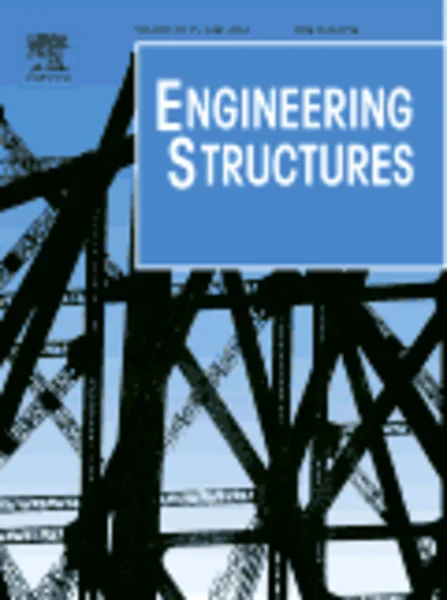-
dynamic analysis methodology for progressive failure of truss structures considering inelastic postbuckling cyclic member behavior
جزئیات بیشتر مقاله- تاریخ ارائه: 1392/07/24
- تاریخ انتشار در تی پی بین: 1392/07/24
- تعداد بازدید: 900
- تعداد پرسش و پاسخ ها: 0
- شماره تماس دبیرخانه رویداد: -
over the years, several catastrophic collapses of truss structures have been reported. sudden failure or reduction in member capacity of a single member in a truss structure gives rise to dynamic force redistribution in the remaining members and may lead to progressive collapse of the entire structure. during failure, truss members can undergo inelastic cyclic behavior (including postbuckling in compression and yielding in tension) that may not have existed in the intact structure. this paper presents a methodology to incorporate the inelastic cyclic member force–deformation behavior in the dynamic analysis of truss structures and at the same time incorporates the possible dynamic effects arising from the sudden change in load carrying capacity of a member due to failure or buckling/postbuckling. the method tracks and generates the force–deformation characteristics of every member of the truss at each incremental time step. the continuous change in the load-carrying capacity and the stiffness of members during the nonlinear force–deformation history has been incorporated in the analysis scheme using the pseudo-force approach. the solution methodology for obtaining the dynamic response of the structure is based on the finite element technique and considers elasto-plastic material and large deformation geometric nonlinearities. the methodology is applied to a two-dimensional three-member toggle redundant truss subjected to external static, quasi-static, and dynamic (sinusoidal and ramp) loads. results delineating the effects of the inelastic cyclic axial force–deformation relation of each member and the time variation of joint displacements and member forces are presented for each loading condition. the results show that there exist cases where modeling a compression member with its actual postbuckling behavior, which although has some reserve load carrying capacity, are more critical than the case where the same member is considered to suddenly lose its full load carrying capacity at its buckling load.
مقالات جدیدترین رویدادها
-
استفاده از تحلیل اهمیت-عملکرد در ارائه الگوی مدیریت خلاقیت سازمانی و ارائه راهکار جهت بهبود
-
بررسی تاثیر ارزش وجوه نقد مازاد بر ساختار سرمایه شرکت های پذیرفته شده در بورس اوراق بهادار تهران
-
بررسی تأثیر سطح افشای ریسک بر قرارداد بدهی شرکت های پذیرفته شده در بورس اوراق بهادار تهران
-
بررسی تأثیر رتبه بندی اعتباری مبتنی بر مدل امتیاز بازار نوظهور بر نقد شوندگی سهام با تأکید بر خصوصی سازی شرکت ها
-
تأثیر آمیخته بازاریابی پوشاک ایرانی بر تصویر ذهنی مشتری پوشاک ایرانی (هاکوپیان)
-
عملکرد لرزه ای بنای تاریخی کعبه زرتشت بر مبنای روش المان مجزا
-
محاسبه فاکتور ظرفیت باربری ny برای پی های حلقوی با استفاده از روش خطوط مشخصه
-
تاثیر نانو ذرات رس بر خصوصیات مکانیکی و فیزیکی بتن های متراکم
-
simultaneous biodegradation of ni–citrate complexes and removal of nickel from solutions by pseudomonas alcaliphila
-
effect of vacuum heat treatment on microstructure and microhardness of cold-sprayed tin particle-reinforced al alloy-based composites
مقالات جدیدترین ژورنال ها
-
مدیریت و بررسی افسردگی دانش آموزان دختر مقطع متوسطه دوم در دروان کرونا در شهرستان دزفول
-
مدیریت و بررسی خرد سیاسی در اندیشه ی فردوسی در ادب ایران
-
واکاوی و مدیریت توصیفی قلمدان(جاکلیدی)ضریح در موزه آستان قدس رضوی
-
بررسی تاثیر خلاقیت، دانش و انگیزه کارکنان بر پیشنهادات نوآورانه کارکنان ( مورد مطالعه: هتل های 3 و 4 ستاره استان کرمان)
-
بررسی تاثیر کیفیت سیستم های اطلاعاتی بر تصمیم گیری موفق در شرکتهای تولیدی استان اصفهان (مورد مطالعه: مدیران شرکتهای تولیدی استان اصفهان)
-
بررسی تاثیر سبک رهبری تحول گرا و تبادلی بر کیفیت زندگی کاری
-
تأثیر پدیده مال سازی بر فضایِ شهری امروز ایران
-
تاثیر شوک های حاصل از نوسانات ارز بر رشد اقتصادی افغانستان
-
حضور زنان در کمیته حسابرسی: حق الزحمه حسابرسی و نوع اظهار نظر حسابرس مستقل
-
relationship of spiritual intelligence and personality traits with married individuals’ lifestyle




سوال خود را در مورد این مقاله مطرح نمایید :